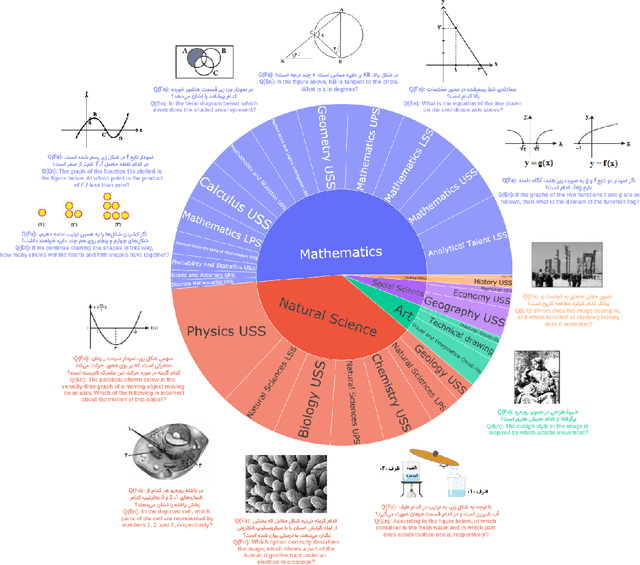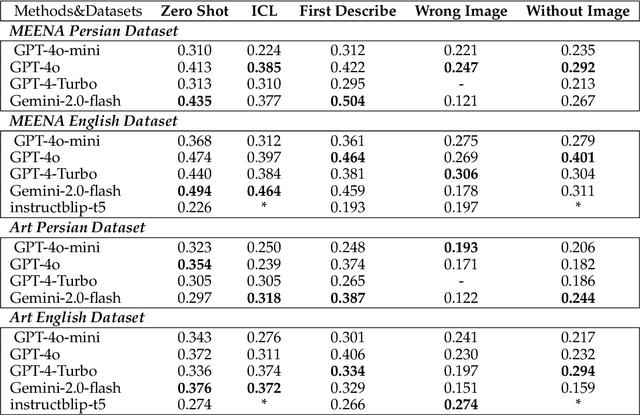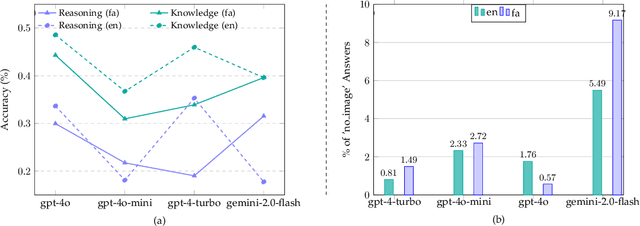Mohammad Hossein Rohban
MEENA (PersianMMMU): Multimodal-Multilingual Educational Exams for N-level Assessment
Aug 24, 2025



Abstract:Recent advancements in large vision-language models (VLMs) have primarily focused on English, with limited attention given to other languages. To address this gap, we introduce MEENA (also known as PersianMMMU), the first dataset designed to evaluate Persian VLMs across scientific, reasoning, and human-level understanding tasks. Our dataset comprises approximately 7,500 Persian and 3,000 English questions, covering a wide range of topics such as reasoning, mathematics, physics, diagrams, charts, and Persian art and literature. Key features of MEENA include: (1) diverse subject coverage spanning various educational levels, from primary to upper secondary school, (2) rich metadata, including difficulty levels and descriptive answers, (3) original Persian data that preserves cultural nuances, (4) a bilingual structure to assess cross-linguistic performance, and (5) a series of diverse experiments assessing various capabilities, including overall performance, the model's ability to attend to images, and its tendency to generate hallucinations. We hope this benchmark contributes to enhancing VLM capabilities beyond English.
PatchGuard: Adversarially Robust Anomaly Detection and Localization through Vision Transformers and Pseudo Anomalies
Jun 10, 2025Abstract:Anomaly Detection (AD) and Anomaly Localization (AL) are crucial in fields that demand high reliability, such as medical imaging and industrial monitoring. However, current AD and AL approaches are often susceptible to adversarial attacks due to limitations in training data, which typically include only normal, unlabeled samples. This study introduces PatchGuard, an adversarially robust AD and AL method that incorporates pseudo anomalies with localization masks within a Vision Transformer (ViT)-based architecture to address these vulnerabilities. We begin by examining the essential properties of pseudo anomalies, and follow it by providing theoretical insights into the attention mechanisms required to enhance the adversarial robustness of AD and AL systems. We then present our approach, which leverages Foreground-Aware Pseudo-Anomalies to overcome the deficiencies of previous anomaly-aware methods. Our method incorporates these crafted pseudo-anomaly samples into a ViT-based framework, with adversarial training guided by a novel loss function designed to improve model robustness, as supported by our theoretical analysis. Experimental results on well-established industrial and medical datasets demonstrate that PatchGuard significantly outperforms previous methods in adversarial settings, achieving performance gains of $53.2\%$ in AD and $68.5\%$ in AL, while also maintaining competitive accuracy in non-adversarial settings. The code repository is available at https://github.com/rohban-lab/PatchGuard .
CLIP Under the Microscope: A Fine-Grained Analysis of Multi-Object Representation
Feb 27, 2025



Abstract:Contrastive Language-Image Pre-training (CLIP) models excel in zero-shot classification, yet face challenges in complex multi-object scenarios. This study offers a comprehensive analysis of CLIP's limitations in these contexts using a specialized dataset, ComCO, designed to evaluate CLIP's encoders in diverse multi-object scenarios. Our findings reveal significant biases: the text encoder prioritizes first-mentioned objects, and the image encoder favors larger objects. Through retrieval and classification tasks, we quantify these biases across multiple CLIP variants and trace their origins to CLIP's training process, supported by analyses of the LAION dataset and training progression. Our image-text matching experiments show substantial performance drops when object size or token order changes, underscoring CLIP's instability with rephrased but semantically similar captions. Extending this to longer captions and text-to-image models like Stable Diffusion, we demonstrate how prompt order influences object prominence in generated images. For more details and access to our dataset and analysis code, visit our project repository: https://clip-analysis.github.io.
Analyzing CLIP's Performance Limitations in Multi-Object Scenarios: A Controlled High-Resolution Study
Feb 27, 2025



Abstract:Contrastive Language-Image Pre-training (CLIP) models have demonstrated remarkable performance in zero-shot classification tasks, yet their efficacy in handling complex multi-object scenarios remains challenging. This study presents a comprehensive analysis of CLIP's performance limitations in multi-object contexts through controlled experiments. We introduce two custom datasets, SimCO and CompCO, to evaluate CLIP's image and text encoders in various multi-object configurations. Our findings reveal significant biases in both encoders: the image encoder favors larger objects, while the text encoder prioritizes objects mentioned first in descriptions. We hypothesize these biases originate from CLIP's training process and provide evidence through analyses of the COCO dataset and CLIP's training progression. Additionally, we extend our investigation to Stable Diffusion models, revealing that biases in the CLIP text encoder significantly impact text-to-image generation tasks. Our experiments demonstrate how these biases affect CLIP's performance in image-caption matching and generation tasks, particularly when manipulating object sizes and their order in captions. This work contributes valuable insights into CLIP's behavior in complex visual environments and highlights areas for improvement in future vision-language models.
Scanning Trojaned Models Using Out-of-Distribution Samples
Jan 28, 2025



Abstract:Scanning for trojan (backdoor) in deep neural networks is crucial due to their significant real-world applications. There has been an increasing focus on developing effective general trojan scanning methods across various trojan attacks. Despite advancements, there remains a shortage of methods that perform effectively without preconceived assumptions about the backdoor attack method. Additionally, we have observed that current methods struggle to identify classifiers trojaned using adversarial training. Motivated by these challenges, our study introduces a novel scanning method named TRODO (TROjan scanning by Detection of adversarial shifts in Out-of-distribution samples). TRODO leverages the concept of "blind spots"--regions where trojaned classifiers erroneously identify out-of-distribution (OOD) samples as in-distribution (ID). We scan for these blind spots by adversarially shifting OOD samples towards in-distribution. The increased likelihood of perturbed OOD samples being classified as ID serves as a signature for trojan detection. TRODO is both trojan and label mapping agnostic, effective even against adversarially trained trojaned classifiers. It is applicable even in scenarios where training data is absent, demonstrating high accuracy and adaptability across various scenarios and datasets, highlighting its potential as a robust trojan scanning strategy.
RODEO: Robust Outlier Detection via Exposing Adaptive Out-of-Distribution Samples
Jan 28, 2025Abstract:In recent years, there have been significant improvements in various forms of image outlier detection. However, outlier detection performance under adversarial settings lags far behind that in standard settings. This is due to the lack of effective exposure to adversarial scenarios during training, especially on unseen outliers, leading to detection models failing to learn robust features. To bridge this gap, we introduce RODEO, a data-centric approach that generates effective outliers for robust outlier detection. More specifically, we show that incorporating outlier exposure (OE) and adversarial training can be an effective strategy for this purpose, as long as the exposed training outliers meet certain characteristics, including diversity, and both conceptual differentiability and analogy to the inlier samples. We leverage a text-to-image model to achieve this goal. We demonstrate both quantitatively and qualitatively that our adaptive OE method effectively generates ``diverse'' and ``near-distribution'' outliers, leveraging information from both text and image domains. Moreover, our experimental results show that utilizing our synthesized outliers significantly enhances the performance of the outlier detector, particularly in adversarial settings.
A Contrastive Teacher-Student Framework for Novelty Detection under Style Shifts
Jan 28, 2025



Abstract:There have been several efforts to improve Novelty Detection (ND) performance. However, ND methods often suffer significant performance drops under minor distribution shifts caused by changes in the environment, known as style shifts. This challenge arises from the ND setup, where the absence of out-of-distribution (OOD) samples during training causes the detector to be biased toward the dominant style features in the in-distribution (ID) data. As a result, the model mistakenly learns to correlate style with core features, using this shortcut for detection. Robust ND is crucial for real-world applications like autonomous driving and medical imaging, where test samples may have different styles than the training data. Motivated by this, we propose a robust ND method that crafts an auxiliary OOD set with style features similar to the ID set but with different core features. Then, a task-based knowledge distillation strategy is utilized to distinguish core features from style features and help our model rely on core features for discriminating crafted OOD and ID sets. We verified the effectiveness of our method through extensive experimental evaluations on several datasets, including synthetic and real-world benchmarks, against nine different ND methods.
Mitigating Spurious Negative Pairs for Robust Industrial Anomaly Detection
Jan 26, 2025



Abstract:Despite significant progress in Anomaly Detection (AD), the robustness of existing detection methods against adversarial attacks remains a challenge, compromising their reliability in critical real-world applications such as autonomous driving. This issue primarily arises from the AD setup, which assumes that training data is limited to a group of unlabeled normal samples, making the detectors vulnerable to adversarial anomaly samples during testing. Additionally, implementing adversarial training as a safeguard encounters difficulties, such as formulating an effective objective function without access to labels. An ideal objective function for adversarial training in AD should promote strong perturbations both within and between the normal and anomaly groups to maximize margin between normal and anomaly distribution. To address these issues, we first propose crafting a pseudo-anomaly group derived from normal group samples. Then, we demonstrate that adversarial training with contrastive loss could serve as an ideal objective function, as it creates both inter- and intra-group perturbations. However, we notice that spurious negative pairs compromise the conventional contrastive loss to achieve robust AD. Spurious negative pairs are those that should be closely mapped but are erroneously separated. These pairs introduce noise and misguide the direction of inter-group adversarial perturbations. To overcome the effect of spurious negative pairs, we define opposite pairs and adversarially pull them apart to strengthen inter-group perturbations. Experimental results demonstrate our superior performance in both clean and adversarial scenarios, with a 26.1% improvement in robust detection across various challenging benchmark datasets. The implementation of our work is available at: https://github.com/rohban-lab/COBRA.
Killing it with Zero-Shot: Adversarially Robust Novelty Detection
Jan 25, 2025



Abstract:Novelty Detection (ND) plays a crucial role in machine learning by identifying new or unseen data during model inference. This capability is especially important for the safe and reliable operation of automated systems. Despite advances in this field, existing techniques often fail to maintain their performance when subject to adversarial attacks. Our research addresses this gap by marrying the merits of nearest-neighbor algorithms with robust features obtained from models pretrained on ImageNet. We focus on enhancing the robustness and performance of ND algorithms. Experimental results demonstrate that our approach significantly outperforms current state-of-the-art methods across various benchmarks, particularly under adversarial conditions. By incorporating robust pretrained features into the k-NN algorithm, we establish a new standard for performance and robustness in the field of robust ND. This work opens up new avenues for research aimed at fortifying machine learning systems against adversarial vulnerabilities. Our implementation is publicly available at https://github.com/rohban-lab/ZARND.
Diffusion Beats Autoregressive: An Evaluation of Compositional Generation in Text-to-Image Models
Oct 30, 2024


Abstract:Text-to-image (T2I) generative models, such as Stable Diffusion and DALL-E, have shown remarkable proficiency in producing high-quality, realistic, and natural images from textual descriptions. However, these models sometimes fail to accurately capture all the details specified in the input prompts, particularly concerning entities, attributes, and spatial relationships. This issue becomes more pronounced when the prompt contains novel or complex compositions, leading to what are known as compositional generation failure modes. Recently, a new open-source diffusion-based T2I model, FLUX, has been introduced, demonstrating strong performance in high-quality image generation. Additionally, autoregressive T2I models like LlamaGen have claimed competitive visual quality performance compared to diffusion-based models. In this study, we evaluate the compositional generation capabilities of these newly introduced models against established models using the T2I-CompBench benchmark. Our findings reveal that LlamaGen, as a vanilla autoregressive model, is not yet on par with state-of-the-art diffusion models for compositional generation tasks under the same criteria, such as model size and inference time. On the other hand, the open-source diffusion-based model FLUX exhibits compositional generation capabilities comparable to the state-of-the-art closed-source model DALL-E3.
 Add to Chrome
Add to Chrome Add to Firefox
Add to Firefox Add to Edge
Add to Edge